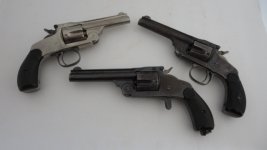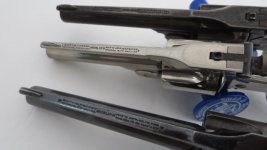Why is the 38 Smith & Wesson Single Action, 3rd Model (Model of 1891) So Scarce?
Before I start, I would like to thank all of our Forum experts and S&W authors who have added information and comments to this commentary. I have been perplexed by the lack of 38 Single Action, Third Model, or Model of 1891 revolvers on the market and have been researching this phenomenon. As most know, these revolvers rarely come up for sale, but the question is why? There were more 38 Single Action Third Models made than the Model 3 American and the Americans are regularly seen for sale. Another comparison is that I find more No. 3, 2nd Model Commercial Russians for sale and only 6200 were supposedly made. According to the Standard Catalog of Smith & Wesson, 3rd ed. By Supica and Nahas, there were 26,850 of these revolvers manufactured, so why do we rarely see them for sale?

38 Smith & Wesson Single Action, Third Model Target Revolver

38 Smith & Wesson First Model Single Shot
The 38 Single Action, Third Model revolver was manufactured from 1891 to 1911. This gun came in 3¼”, 4”, 5”, and 6” barrel lengths and was available in nickel or blue. It is stated in various sources that almost all had “Model of 91” stamped in the middle of the barrel top rib address line, but some double action barrels were supposedly used as well on factory guns. I have not been able to locate any documented examples with matching serial numbers on frame and barrel that lack the “Model of 91” stamping. Those I have encountered had mixed serial numbers.

38 SA Barrel Stamping
The standard stocks were black hard rubber, round butt, but monogrammed pearl stocks and hard rubber or walnut target stocks were available at a premium. After-market pearl stocks were also very popular around the turn of the twentieth century.

Standard

Factory Pearls

HR Target

Walnut Target

Aftermarket Pearl
An additional option for this model was target front and rear sights. Factory target versions of the 38 S&W SA, Third Model should be considered rare, certainly only a small percentage of these guns were furnished with target sights. In the 1900 S&W Catalog, the rear target sight was available for an additional $2.00, the Lyman front sight added another $1.75, while replacement black hard rubber stocks were $0.25 each.

1900 S&W Catalog

Rear target sight

Lyman Front Target Sight Available from the Factory

Flat Blade Front Sight
As for value, a quick look at historical references is of interest. Martin Rywell’s 1953 book states that the 1891 revolver was worth $25.00, while the 1891 Single Shot was valued at $35.00. Rywell revisited S&W values in his 1962 work and the values remained the same. Rock Island’s April 2013 auction had 2 non-target Model of 91 SA revolvers available, in perhaps Very Good condition with major bluing loss at the cylinders. They sold for $2500 each, which is far above SCSW’s 2006 valuation of $650.
What I have been able to determine is that there were a total of 28,107 Model of ’91s manufactured in a few configurations. According to Neal/Jinks 1966 book Smith & Wesson 1857-1945, there were 3198 First Model single shot barrels made, but only 1251 were originally sold as single shots. There were also 92 combination sets shipped from the factory. This would dictate that all the remaining barrels were used post-factory. Neal/Jinks also states that the Mexican Model totaled 2000 or so. This leaves over 24,764 revolvers made.

38 Smith & Wesson Single Action, Third Model, Mexican Model
McHenry & Roper’s 1958 Smith & Wesson Handguns, is contrary to Neal & Jinks and suggested that most of the 3196 Single Shot barrels were used in factory combination sets or First Model single shot configurations. This is an interesting statement since, in the current market, Single Shot sales seem to outnumber 1891 SAs by a large margin. Single Shots are prevalent on almost all major gun auction sites, but there were supposedly twenty times more 1891 SAs made than Single Shots. Lastly, the SWCA Database has only 17 - 1891 SAs (<1% of all made), while having 27 – 1st Model Single Shots (2% of all made). McHenry & Roper also state that 7000 Mexican Models were manufactured.
When compared to the 38 Single Action 1st Model (Baby Russian), as stated by Jim Supica, there are 10 Baby Russians for sale for every Model of 91 38 SA, yet they were made in nearly equal numbers!
I was reading Martin Rywell’s 1953 edition of Smith & Wesson – The Story of the Revolver. He claims that 7,000 Model of 1891 revolvers were made for the Russian trade. He also mentions the Mexican Model, but no production numbers were stated.
Even if we add these 7,000 Russian trade revolvers into the equation and 3000 First Model Single Shots, the total of revolvers made is reduced to just over 13,700. Still seems like enough that you would see them in trade from time to time.
Our last option is to look at attrition rates. Using attrition rates for durable goods does not work for firearms, since applying that regression virtually eliminates all 38 SAs by 1960. Just for statistical purposes, if we assume that some revolvers are just lost every year for any number of reasons. Let’s assume this would have mostly occurred from 1891 to 1970. Secondly, there are a number of these revolvers worn out or broken and discarded per year. This would have most likely happened from 1920 to 1960. Lastly, it is known that some 1891s ended up being parted out in more recent years to restore others. This would have mostly happened after the revolver became somewhat collectable, let’s say 1950 to 2013. The reader can use any percentage, but I would think it would be possible to lose ½% per year based on a combination of all the above possibilities. We can reasonably estimate 6000 revolvers might no longer exist. Applying these scenarios and the preceding data, the number of remaining revolvers would be 7700. Now we are getting somewhere, but there will never be any way to verify these numbers.
Questions that remain unanswered:
1. Did S&W actually export 7000 Model 1891 revolvers to Russia?
2. Were there only 2000 Mexican Models made?
3. Were most of the 3196 single shot barrels used in original Single Shots and Combo Sets?
4. Have collectors cornered the market on these revolvers and are they holding onto them?
Roy Jinks has commented that the Model 1891 was a very popular export revolver. He stated the exports went mostly to Europe and South America. This could be the most credible explanation for the rarity of the 38 Single Action, Third Model. If 20% went to foreign countries, it is possible that over 5000 revolvers are not available in the US market. Using all possible reasons as outlined above, the minimum number of 1891s in the US today could be 2700.
Realistically, what we do have is enough evidence to estimate that there may be in the neighborhood of 5000 to 7500 Model 1891s in the US today. There is no way, however, to justify the discrepancy between the apparent numbers of Single Shots, as compared to revolvers, for sale.
This is an interesting model that does not get the attention it deserves. As SCSW-3rd states: “these are very attractive guns and. . . are highly sought after”.
Where they all went may be lost to history.






